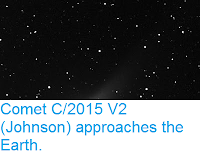Asteroid 2017 MF passed by the Earth at a distance of 391 500 km
(1.01 times the average distance between the Earth and the Moon, 0.26%
of
the average distance between the Earth and the Sun), slightly before 10.30 pm GMT
on Monday 19 June 2017. There was no danger of the asteroid
hitting us, though had it done so it would have presented no threat.
2017 MF has an estimated equivalent diameter of 9-28 m (i.e. it is
estimated that a spherical object with the same volume would be 9-28 m
in diameter), and an object of this size would be expected to explode in
an airburst (an explosion caused by superheating from friction with the
Earth's atmosphere, which is greater than that caused by simply
falling, due to the orbital momentum of the asteroid) in the atmosphere
between 33 and 16 km above the ground, with only fragmentary material
reaching the Earth's surface.
The calculated orbit of 2017 MF. Minor Planet Center.
2017 MF was discovered on 18 June 2017 (the day before its closest approach to the Earth) by the University of Arizona's Catalina Sky Survey,
which is located in the Catalina Mountains north of Tucson. The
designation 2017 MF implies that it was the sixth asteroid (asteroid F)
discovered in the second half of June 2017 (period 2017 M).
2017 MF has a 721 day orbital period and an eccentric orbit
tilted at an angle of 1.37° to the plane of the Solar System, which
takes it from 0.99 AU from the Sun (i.e. 99% of he average distance at
which the Earth orbits the Sun)
to 2.15 AU from the Sun (i.e. 215% of
the
average distance at which the Earth orbits the Sun, considerably more than
the distance at which the planet Mars orbits the Sun).
It is therefore classed as an
Apollo Group Asteroid (an asteroid that is on average further from the
Sun than the Earth, but which does get closer). This means that close
encounters between the asteroid and Earth are common, with the
last having occurred in May 2013 and the next predicted for May 2019. 2017 MF also has occasional close encounters with the planet Mars, with the last calculated to have occurred in December 2000 and the next predicted for April 2074.
See also...
Follow Sciency Thoughts on Facebook.







